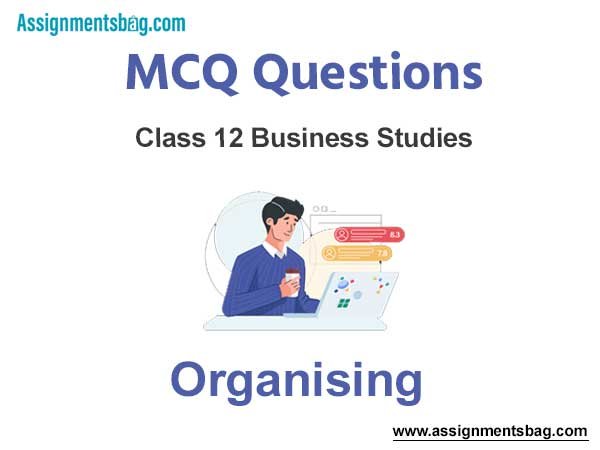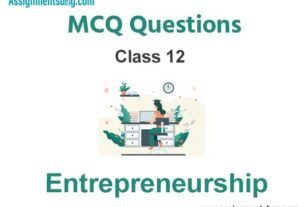Please refer to MCQ Questions Chapter 5 Organising Class Class 12 Business Studies with answers provided below. These multiple-choice questions have been developed based on the latest NCERT book for class 12 Business Studies issued for the current academic year. We have provided MCQ Questions for Class 12 Business Studies for all chapters on our website. Students should learn the objective based questions for Chapter 5 Organising Class in Class 12 Business Studies provided below to get more marks in exams.
Chapter 5 Organising Class MCQ Questions
Please refer to the following Chapter 5 Organising Class MCQ Questions Class 12 Business Studies with solutions for all important topics in the chapter.
Question. Which of the following cannot be delegated?
(a) Authority
(b) Responsibility
(c) Accountability
(d) None of these
Answer
C
Question. Rishabh has joined as a Creative Head in an entertainment company. He always ensures that the work has been divided into small and manageable activities and also the activities of similar nature are grouped together. Identify the related step in organising process being mentioned in the above lines.
(a) Identification and division of work
(b) Departmentalisation
(c) Assignment of duties
(d) Establishing reporting relationships
Answer
B
Question. The accountability flows
(a) In all directions
(b) Downwards
(c) Upwards
(d) None of the above
Answer
D
Question. Identify the correct sequence of steps to be followed in an organising process.
(a) Departmentalisation, Establishing reporting relationships, Assignment of duties, Identification and division of work
(b) Identification and division of work, Departmentalisation, Assignment of duties, Establishing reporting relationships
(c) Identification and division of work, Assignment of duties, Departmentalisation, Establishing reporting relationships
(d) Identification and division of work, Establishing reporting relationships, Departmentalisation, Assignment of duties
Answer
B
Question. When decision-making authority is retained organisation is said to be by higher management levels, an
(a) Decentralised
(b) Centralised
(c) Fragmented
(d) None of the above
Answer
B
Question. Name the process which co-ordinates human efforts, assembles resources and integrates both into a unified whole to be utilized for achieving specified objectives,
(a) Management
(b) Planning
(c) Organising
(d) Directing
Answer
C
Question. Uranus Limited is a company dealing in metal products. The work is mainly divided into functions including production, purchase, marketing, accounts and personnel. Identify the type of organisational structure followed by the organisation.
(a) Functional structure
(b) Relational structure
(c) Divisional structure
(d) None of the above
Answer
A
Question. Which of the following is not a demerit of functional structure?
(a) It places more emphasis on the objectives pursued by a functional head than on overall enterprise objectives.
(b) It may lead to conflict of interests among departments due to varied interests.
(c) It leads to occupational specialisation.
(d) It may lead to difficulty in co-ordination among functionally differentiated departments.
Answer
C
Question. Harshit Lt(d) has grown in size. It was a market leader but with changes in business environment and with the entry of MNCs, its market share is declining. To cope up with the situation CEO starts delegating some of his authority to the General Manager, who also felt himself overburdened and with the approval of CEO disperses some of his authority to various levels throughout the organisation. Identify the concept of management discussed above.
(a) Delegation
(b) Organising
(c) Decentralisation
(d) Centralisation
Answer
C
Question. Under this type of organisational structure, manpower is grouped on the basis of different products manufactured
(a) Divisional structure
(b) Functional structure
(c) Network structure
(d) Matrix structure
Answer
A
Question. In which situation the divisional structure happens to be appropriate?
(a) Where the number of major products is more than one
(b) Where the size of the organisation is quite large
(c) Both (a) and (b)
(d) Where primarily only one product is sold
Answer
C
Question. In order to successfully realize the objectives of an organisation, first of all it is ensured which activities will have to be performe(d) In the list of activities, all the activities, both big and small, are include(d) But it is not possible to set up separate departments for all the activities. Some similar activities are put together in the same department. In this way some necessary departments are set up. The reason for doing so is to exercise control over unnecessary administrative expenses. Identify the concept of management under which similar activities are put together and departments are set up.
(a) Departmentalisation
(b) Delegation
(c) Decentralisation
(d) Centralisation
Answer
C
Question. Centralisation refers to:
(a) Retention of decision-making authority
(b) Dispersal of decision-making authority
(c) Creating divisions as profit centres
(d) Opening new centres or branches
Answer
A
Question. Match the following on the basis of meaning of the content (remembering)
| 1. Divisional structure | (i) formation is based on functions |
| 2. Functional Structure | (ii) number of subordinates that can be managed by superiors |
| 3. Span of management | (iii) product specialization |
(a) (i) (ii) (iii)
(b) (i) (iii) (ii)
(c) (iii) (i) (ii)
(d) (ii) (i) (iii)
Answer
C
Question. It refers to the number of subordinates that can be effectively managed by a superior
(a) Organisational structure
(b) Informal organisation
(c) Span of management
(d) None of the above
Answer
C
Question. Match the following by choosing the correct option:
| 1. Leads to specialization | (i) Delegation |
| 2. Functional anddivisional | (ii) Step of organising process |
| 3. It has narrow scope | (iii) Importance of organization |
| 4. Establishing reporting relationships | (iv) Types of organisation structure |
(a) (i) (ii) (iii) (iv)
(b) (ii) (iv) (i) (iii)
(c) (iii) (iv) (i) (ii)
(d) (iv) (i) (ii) (iii)
Answer
C
Question. As the span of management increases in an organisation, the number of levels of management in the organisation
(a) Increases
(b) Decreases
(c) Remains unaffected
(d) None of the above
Answer
B
Question. Match the following
| 1. Departmentalization | (i) Dividing the work as per plan |
| 2. Assignment of duties | (ii) Allocation of responsibility |
| 3. Division of Work | (iii) The activities which are of similar nature |
(a) (i) (ii) (iii)
(b) (i) (iii) (ii)
(c) (iii) (i) (ii)
(d) (iii) (ii) (i)
Answer
D
Question. Match the following:
| 1. Authority | (i) Arises from formal position |
| 2. accountability | (ii) Arises from delegation of authority |
| 3. Responsibility | (iii) Arises from responsibility |
(a) (i) (ii) (iii)
(b) (i) (iii) (ii)
(c) (iii) (i) (ii)
(d) (iii) (ii) (i)
Answer
B
Question. Match the following:
| 1. Identification and division of work activities | (i) Dividing work into manageable |
| 2. Departmentalisation | (ii) Establishing a hierarchal structure |
| 3. Assignment of duties | (iii) Establishing a hierarchal structure |
| 4. Establishing authority & reporting relationships | (iv) Allocating jobs to the members of each department |
(a) (i) (ii) (iii) (iv)
(b) (ii) (iii) (iv) (ii)
(c) (iii) (iv) (i) (ii)
(d) (iv) (i) (ii) (iii)
Answer
B
Question. It is the obligation of a subordinate to properly perform the assigned duty.
(a) Responsibility
(b) Authority
(c) Accountability
(d) All of the above
Answer
A
Question. Which of the following is not a merit of divisional structure?
(a) It promotes product specialisation.
(b) It ensures that different functions get due attention.
(c) It promotes flexibility and faster decision making.
(d) It facilitates expansion and growth as new divisions.
Answer
B
Question. Match the following on the basis of demerits of the content:
| 1. Divisional structure | (i) Difficult for a multiproduct company |
| 2. Functional Structure | (ii) Difficult to fix responsibility |
| (iii) Non economical |
(a) (i) (ii)
(b) (ii) (i)
(c) (iii) (i)
(d) (ii) (iii)
Answer
C
Question. Match the following:
| 1. Divisional structure | (i) occupational Specialization |
| 2. Functional Structure | (ii) Perfect control |
| (iii) Business Environment |
(a) (i) (ii)
(b) (ii) (i)
(c) (iii) (i)
(d) (ii) (iii)
Answer
B
Question.It is a limitation of functional structure
(a) functional empire
(b) decentralization
(c) fucntional specialization.
(d) create chaos.
Answer
A
Question.A tall structure as a
(a) narrow span of management
(b) wide span of management
(c) no span of management
(d) less span of management.
Answer
A
Question. The organisation structure can be defined as a framework within which
(a) Sequence of job positions given
(b) Managerial and operational tasks are performed
(c) formal relationships are specified
(d) Coordination is obtained
Answer
B
Question. Which of the following is not a part of organizing process
(a) division of work
(b) assigning of responsibility.
(c) specialization.
(d) establising reporting relationship
Answer
C
Question.Last step of organizing process
(a) identification and division of work
(b) departmentalization
(c) Assignment of duties.
(d) estabilishing reporting system.
Answer
A
Question. Which of the following does not follow the principle of scalar chain
(a) Formal organization
(b) Informal organisation
(c) Functional structure
(d) Divisional structure
Answer
B
Question. Decentralisation is
(a) Selected dispersal of authority.
(b) Authority to be retained by top level.
(c) Trfer of responsibility to lower levels without authority.
(d) Dispersal of authority to the subordinates within prescribed limits.
Answer
A
Question. Which of the following is not an element of delegation
(a) accountability
(b) authority
(c) resposibility
(d) informal organization.
Answer
D
Question. Span of management refers to
(a) Number of managers in an organisation
(b) Length of term for which a manager is recruited
(c) Number o subordinates under a superior
(d) Number of managers in a top management.
Answer
C
Question. Delegation of authority merely me the granting of authority to subordinates to operate
(a) Within prescribed limits
(b) Beyond prescribed limits
(c) If commensurate with responsibility
(d) Only when required
Answer
A
Question. Assertion (A): Decentralisation should be applied with caution by the top management.
Reason (R): It can lead to organisational disintegration if the departments start to operate on their own guidelines which may be contrary to the interest of the organisation.
(a) Both Assertion (A) and reason (R) are true.
(b) Both Assertion (A) and reason (R) are false
(c) Assertion (A) is trueand reason (R) is false
(d) Assertion (A) is false and reason (R) is true
Answer
A
Question. Assertion(A): Functional Organization helps in increasing managerial and operational efficiency and this results in increased profit.
Explanation(R): Functional Organization promotes efficiency in utilisation of manpower as employees perform similar tasks within a department and are able to improve performance.
(a) Both (A) and (R) are true and (R) is the correct explanation of (A)
(b) Both (A) and (R) are true but (R) is not the correct explanation of A
(c) (A) is true, but (R) is false
(d) (A) is false, but (R) is true
Answer
A
Question. Assertion(A):Identification and division of work is the first step in the process of organising.
Reason (R): Organising involves identifying and dividing the work that has to be done in accordance with previously determined plans.
(a) Both (A) and (R) are true and (R) is the correct explanation of (A)
(b) Both (A) and (R) are true and (R) is not the correct explanation of A
(c) (A) is true, but (R) is false
(d) (A) is false, but (R) is true
Answer
A
Question. Assertion(A): Organising helps management in implementing the principle of initiative among employees.
Explanation(R): Organising satisfies the subordinate’s need for recognition and provides them with opportunities to develop and exercise initiative.
(a) Both (A) and (R) are true and (R) is the correct explanation of (A)
(b) Both (A) and (R) are true but (R) is not the correct explanation of A
(c) (A) is true, but (R) is false
(d) (A) is false, but (R) is true
Answer
A
Question. Assertion(A): Authority determines the superior subordinate relationship wherein the superior communicates his decision to the subordinate, expecting compliance from him and the subordinate executes the decision as per the guidelines of the superior.
Explanation(R): Accountability is the obligation of a subordinate to properly perform the assigned duty.
(a) Both (A) and (R) are true and (R) is the correct explanation of (A)
(b) Both (A) and (R) are true but (R) is not the correct explanation of A
(c) (A) is true, but (R) is false
(d) (A) is false, but (R) is true
Answer
C
Question. Assertion(A):Assertion (A): Organising provides a cleardescription of jobs and related duties.
Reason (R): Organising stimulates creativity amongst the managers.
(a) Both (A) and (R) are true and (R) is the correct explanation of (A)
(b) Both (A) and (R) are true but (R) is not the correct explanation of A
(c) (A) is true, but (R) is false
(d) (A) is false, but (R) is true
Answer
B
Question. Assertion (A): Delegation helps a manager to extend his area of operations as without it, his activities would be restricted to only what he himself can do.
Reason (R): A manager, no matter how capable he is, cannot manage to do every task on his own. The volume of work makes it impractical for him to handle it all by himself.
(a) Both Assertion (A) and reason (R) are true.
(b) Both Assertion (A) and reason (R) are false
(c) Assertion (A) is trueand reason (R) is false
(d) Assertion (A) is false and reason (R) is true
Answer
A
Question. Assertion (A): Delegation does not mean abdication.
Reason (R): A manager is under obligation to perform the delegated task.
(a) Both Assertion (A) and reason (R) are true.
(b) Both Assertion (A) and reason (R) are false
(c) Assertion (A) is true and reason (R) is false
(d) Assertion (A) is false and reason (R) is true
Answer
C
Question. Assertion (A): The span of management at the upper level is generally narrow while at the lower level span is wide.
Reason (R) : The task allocated to subordinates at the lower level of management are more specific and precise and thus making supervision easy and simple.
(a) (A) is correct, but (R) is wrong
(b) (A) is wrong, but (R) is correct
(c) Both (A) and (R) are correct
(d) Both (A) and (R) are wrong
Answer
C
Question. Assertion (A): Responsibility is derived from authority and accountability is derived from responsibility.
Reason (R): Responsibility is the obligation of a subordinate to properly perform the assigned duty, for which he/she has been delegated authority by his/her superior. Once authority has been delegated and responsibility accepted, one cannot deny accountability.
(a) Both Assertion (A) and reason (R) are true.
(b) Both Assertion (A) and reason (R) are false
(c) Assertion (A) is trueand reason (R) is false
(d) Assertion (A) is false and reason (R) is true
Answer
A
Question. Assertion (A): A large sized organisation can be totally decentralise(d)
Reason (R): As an organisation grows in size and complexity, there is a tendency to move towards decentralised decision-making. Complete centralisation would imply concentration of all decision making functions at the apex of the management hierarchy.
(a) Both Assertion (A) and reason (R) are true.
(b) Both Assertion (A) and reason (R) are false
(c) Assertion (A) is trueand reason (R) is false
(d) Assertion (A) is false and reason (R) is true
Answer
D
Question. Assertion (A): Organisation structure is an indispensable means; and the wrong structure will seriously impair business performance and even destroy it.
Reason (R): A proper organisation structure is essential to ensure a smooth flow of communication and better control over the operations of a business enterprise. It specifies the relationships between people, work and resources.
(a) Both Assertion (A) and reason (R) are true.
(b) Both Assertion (A) and reason (R) are false
(c) Assertion (A) is trueand reason (R) is false
(d) Assertion (A) is false and reason (R) is true
Answer
A
Question. Assertion (A): Decentralisation must always be balanced with centralisation in areas of major policy decisions.
Reason (R): Decentralisation recognises the decision maker’s need for autonomy. The management, however, needs to carefully select those decisions which will be pushed down to lower levels and those that will be retained for higher levels.
(a) Both Assertion (A) and reason (R) are true.
(b) Both Assertion (A) and reason (R) are false
(c) Assertion (A) is trueand reason (R) is false
(d) Assertion (A) is false and reason (R) is true
Answer
A
Question. Assertion (A): Organisation structure is the outcome of the planning process.
Reason (R): The organising process leads to the creation of an organisation structure which includes the designing of roles to be filled by suitably skilled people and defining the inter- relationship between these roles so that ambiguity in performance of duties can be eliminate(d)
(a) Both Assertion (A) and reason (R) are true.
(b) Both Assertion (A) and reason (R) are false
(c) Assertion (A) is trueand reason (R) is false
(d) Assertion (A) is false and reason (R) is true
Answer
D
Question. Assertion (A): The need for an adequate organisation structure is felt by an enterprise whenever it grows in size or complexity.
Reason (R): As an organisation grows, coordination becomes difficult due to the emergence of new functions and increase in structural hierarchies. Thus, for an organisation to function smoothly and face environmental changes, it becomes necessary to pay attention to its structure.
(a) Both Assertion (A) and reason (R) are true.
(b) Both Assertion (A) and reason (R) are false
(c) Assertion (A) is trueand reason (R) is false
(d) Assertion (A) is false and reason (R) is true
Answer
A
Fill In The Blanks:
Question. —————– is the process of decision making where all the authority is retained with top level management.
Answer
centralization
Question. Functional heads cannot be managers because they are unable to gather experience in ———— areas.
Answer
different
Question. Organising helps in the growth and —————— of an enterprises.
Answer
diversification
Question. Decetralization gives —————- to top management.
Answer
relief
Question. Functional structure is suitable when the size of organization is ———— .
Answer
large
Question. The —————— of authority flows downward from the superior to subordinate.
Answer
Delegation
Question. Organising as a ———— of management establishes working relationship.
Answer
function
Question. In divisional structure, the organizational structure comprises separate ———— .
Answer
divisions
Question. Organizational structure is classified into functional and ———— .
Answer
divisional
Question. Delegation of authority means sharing ————— with subordinates.
Answer
responsibility
True/ False:
Question. Scalar chain is the perfect example of delegation.
Answer
True
Question. Organising is foremost function of management.
Answer
False
Question.Organising eliminate ambiguity among subordinates.
Answer
True
Question. Oganisational structure is the framework within which managerial and operating tasks are performed.
Answer
True
Question. Delegation intend to ease the burden of manager.
Answer
True
Question. Functional structure does not promote efficiency as employees perform similar tasks.
Answer
False
Question. Functional structure is economical than divisional structure.
Answer
True
Question. A pitfall of organizing is that repetitive performance of same job leads to monotony, stress nad boredom.
Answer
True
Question. Smooth flow of communication is not the result of proper organization structure.
Answer
False
Question. Organising as a function of management responsible for successful implementation of plan.
Answer
True
Match the following:
Question.
| a.Importance of delegation includes | 1.employee development |
| b.decentralization is | 2.Higher absenteism |
| 3.conflicts | |
| 4.optional |
Answer
a-1,b-4
Question.
| a.Authority is related to | 1.power distribution |
| b.accountability cannot be | 2.abdiction |
| 3.delegated | |
| 4.gang plank |
Answer
a-1,b-3
Question.
| a.centralization is | 1.barrier to progress |
| b.Is a element of delegation | 2.Retention of decision making authority |
| 3.Accountability |
Answer
a-2, b-3
Question.
| a.functional structure determines | 1. Product specialization |
| b.divisional structure determines | 2.department coordination |
| 3.Relief to top management |
Answer
a-2,b-1
Question.
| a.formal organisization originates from | 1.right of employees |
| b.Informal organization originates from | 2.top management |
| 3.result of social interaction among employee |
Answer
a-2,b-3
Question.
| a.responsibility means | 1.abdiction |
| b.accountability means | 2.obligation |
| 3.power | |
| 4.rights |
Answer
a-2,b-1
Question.
| a.informal organization originates due to | 1.social interaction |
| 2.Obligation of employee | |
| 3.pressure of labour union |
Answer
a-1
Question.
| a.decentralization is | 1.compulsary |
| b.delegation is | 2.imposed |
| 3.optional | |
| 4.regulatory |
Answer
a-3,b-1

We hope you liked the above provided MCQ Questions Chapter Organising Class Class 12 Business Studies with solutions. If you have any questions please ask us in the comments box below.


